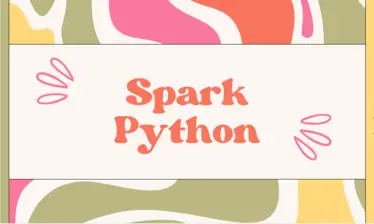Spark Python is a data processing framework that has gained significant popularity in recent years. It is available both as an open-source project, as well as commercial providers such as Databricks, and provides a unified analytics engine for large-scale data processing.
Spark Python is built on top of the Apache Spark project and provides a Python API for data processing.
More recently, “Spark Python” is better known as “PySpark” and PySpark is how it is most often referred to on this site.
Anyhow, one of the key advantages of using Spark Python is its ability to process large volumes of data in a distributed fashion. Distributed, in this case, means compute processing is spread across multiple nodes to promote parallelism and horizontal scale.
Spark Python can be used to process data stored in a variety of formats, including Hadoop Distributed File System (HDFS) and Amazon S3. It is found across a variety of industries, including finance, healthcare, and retail.
The Python API provided by Spark Python is designed to be intuitive and easy to learn, even for those with little or no experience in data processing. The other option is Scala which is covered elsewhere in the Spark Scala section of this site.
Table of Contents
- Spark Python Overview
- Installing Spark Python
- Fundamentals of Spark Python
- Advanced Topics in Spark Python
- Best Practices in Spark Python
- Wrapping Up
Spark Python Overview
Spark Python is built on top of Apache Spark, which is an open-source data processing engine that provides fast, in-memory processing of large datasets. Spark Python is used by data scientists, developers, and analysts to build and deploy big data applications.
Spark Python provides a simple and easy-to-use programming interface that allows developers to write complex data processing applications with ease. Apache Spark supports multiple programming languages, including Python, Java, and Scala.
However, Python is the most popular programming language used for Spark development due to its simplicity and ease of use.
Installing Spark Python

System Requirements
Before installing Spark Python, it is important to ensure that the system meets the necessary requirements. The following table outlines the minimum system requirements for Spark Python:
| Requirement | Minimum |
|---|---|
| Operating System | Linux, macOS, or Windows |
| Python | 2.7.x or 3.4+ |
| Java | 8+ |
| Memory | At least 8GB |
| Disk Space | At least 10GB |
It is recommended to have a multi-core processor for optimal performance.
Installation Process
The installation process for Spark Python is pretty straightforward. Follow these steps:
- Download the latest version of Apache Spark from the official website.
- Extract the downloaded file to a directory of your choice; i.e. mine is extracted into a directory named
/Users/toddmcg/dev/spark-3.4.0-bin-hadoop3 - Optional: set the environment variables for Spark and Python. For example, for Linux or macOS, add the following lines to your
.bashrcor.bash_profilefile:
export SPARK_HOME=/Users/toddmcg/dev/spark-3.4.0-bin-hadoop3
export PATH=$SPARK_HOME/bin:$PATH
export PYSPARK_PYTHON=/path/to/python- Start the Spark Shell by running the following command (or call the
pysparkexecutably directly, if you didn’t set the SPARK_HOME variable in previous step):
$SPARK_HOME/bin/pyspark- Verify the installation by running a simple test:
>>> df = spark.createDataFrame([("one",1),("two", 2),("three",3)])
>>> df.count()
3If the installation was successful, the output should be 3.
By following the steps outlined above, users can easily set up Spark Python and start working in the PySpark shell which is a great place to learn and experiment before writing full fledge PySpark programs.
Fundamentals of Spark Python
Data Structures
One of the key features of Spark Python is its support for various data structures such as RDDs (Resilient Distributed Datasets), DataFrames, and Datasets.
This can be confusing at first, but here’s the are the key takeaways:
RDDs are the original, fundamental building blocks of Spark Python and are immutable distributed collections of objects that can be processed in parallel. They are fault-tolerant and can be rebuilt in case of node failure. They are not preferred choice for data abstraction anymore though.
DataFrames, on the other hand, are distributed collections of data organized into named columns. They replaced RDDs and are more similar to tables in a relational database and can be manipulated using SQL-like operations.
Datasets are the most recent addition to Spark and are strongly typed, allowing for type-safe processing. They provide the benefits of both RDDs and DataFrames, offering a balance between the two.
Data Processing
Spark Python provides a wide range of data processing capabilities, including transformations and actions. Transformations are operations that transform an RDD or DataFrame into another RDD or DataFrame, while actions are operations that return a result or trigger a computation. These transformations happen lazily — meaning the transforms only happen when they have to and never before. This will make more sense as we proceed. Actions, on the other hand, produce a result and not another RDD or DataFrame.
Some common transformations include map, filter, and reduceByKey, while actions include count, collect, and save. These operations can be combined to perform complex data processing tasks such as machine learning, graph processing, and more.
In addition, Spark Python supports various libraries for data processing such as PySpark SQL, MLlib, and GraphX. PySpark SQL provides a SQL interface to Spark Python, allowing users to perform SQL-like operations on DataFrames. MLlib is a library for machine learning that provides various algorithms for classification, regression, and clustering. GraphX is a library for graph processing that provides an API for creating and manipulating graphs.
Advanced Topics in Spark Python
Machine Learning
Spark Python is a powerful tool for implementing machine learning models. It has several libraries that provide support for machine learning tasks such as classification, regression, clustering, and more. One such library is MLlib, which is a scalable machine learning library that provides a wide range of algorithms for processing large datasets.
MLlib provides support for several machine learning tasks such as:
- Classification: MLlib provides support for several classification algorithms such as logistic regression, decision trees, and random forests.
- Regression: MLlib provides support for several regression algorithms such as linear regression, generalized linear regression, and decision trees.
- Clustering: MLlib provides support for several clustering algorithms such as k-means clustering, Gaussian mixture models, and latent Dirichlet allocation.
Data Streaming
Spark Python provides support for processing real-time data streams using the Spark Streaming library. Spark Streaming allows developers to process data streams in real-time using the same programming model as batch processing.
Spark Streaming provides support for several data sources such as Kafka, Flume, Twitter, and more. It also provides support for several data processing operations such as filtering, mapping, reducing, and more.
Spark Streaming can be used for several real-time data processing tasks such as:
- Real-time analytics: Spark Streaming can be used to perform real-time analytics on data streams such as clickstream data, social media data, and more.
- Fraud detection: Spark Streaming can be used to detect fraudulent activities in real-time such as credit card fraud, insurance fraud, and more.
- Sensor data processing: Spark Streaming can be used to process real-time sensor data such as temperature, humidity, and more.
In summary, Spark Python provides several advanced features for machine learning and real-time data processing. These features make it a popular choice for large-scale data processing tasks.
Best Practices in Spark Python
Performance Tuning
When working with Spark Python, it is important to optimize performance to ensure efficient processing of large data sets. This may be too advanced for beginners, but for now, here are general best practices guidelines to follow:
- Partitioning: Ensure that the data is partitioned correctly. The number of partitions should be proportional to the number of cores available. This will help distribute the workload evenly and reduce the overhead of data shuffling.
- Caching: Cache frequently accessed data in memory to reduce the number of disk reads. This can be done using the
cache()orpersist()methods. - Broadcasting: Use broadcast variables for small data sets that are used in multiple stages of the computation. This will reduce the overhead of data serialization and transfer.
- Memory Management: Adjust the memory allocation for the driver and executor nodes based on the size of the data set and the available resources.
Debugging Techniques
Here are some techniques that can be used to debug Spark Python applications:
- Logging: Use logging statements to print debug information to the console or log files. This can be done using the
loggingmodule in Python. - Spark UI: Use the Spark UI to monitor the progress of the application and identify any bottlenecks or errors. The UI provides detailed information about the stages, tasks, and nodes involved in the computation.
- Debugging Tools: Use debugging tools like IntelliJ, PyCharm, Eclipse to step through the code and identify errors. These tools provide features like breakpoints, watches, and variable inspection.
By following these best practices and debugging techniques, developers can optimize the performance and reliability of their Spark Python applications.
Wrapping Up
In conclusion, Spark Python is a powerful tool for big data processing and analysis. It provides an easy-to-use interface for developers to write complex algorithms and applications, and its integration with Python makes it a popular choice for data scientists and engineers.
Be sure to check out more Spark Python tutorials such as
Also make sure to document the PySpark API documentation (opens in new tab).

